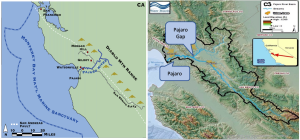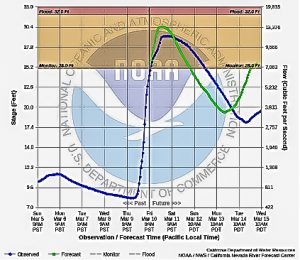Flooding Our Minds with a River of Climate Fear Mongering
UCLA’s Daniel Swain and NPR’s David Romero Collude to Flood Our Minds with a River of Climate Fear Mongering!
By Jim Steele
There have been many news articles about the human suffering caused by the floods that inundated the town of Pajaro in Monterrey County, California on March 11, 2023. But NPR’s article This Winter’s Floods May Be ‘Only a Taste’ of the Megafloods to Come, Climate Scientists Warn was the most disgusting example of how Daniel Swain and National Public Radio dishonestly use any tragedy to fearmonger a climate crisis. Alluding to CO2 driven climate change Swain stated, “As disruptive as this year’s events have been, we’re nowhere near to a plausible worst-case storm and flood scenario for California.”
However, the real story is about government ineptitude and the human risky penchant for building in natural flood plains. When California’s county lines were being drawn up in 1850 as California achieved statehood, the concern was not how to best manage a watershed, but the result of compromises between competing political interests. Thus, the Pajaro River and its main tributary the San Benito River became the dividing line between 4 different counties.
The town of Watsonville, in Santa Cruz County on the north side of the river, and Pajaro, in Monterrey County on the south side, were first developed by non-natives in the 1850s in the middle of the Pajaro River’s flood plain. Floods were common and inevitable. Each winter the returning rains turned the flood plain into a mosaic of meandering streams, marshes, ponds, and flooded fields. So, levees were constructed to prevent flood damage to buildings and agricultural fields. The first levees were built to protect the relatively wealthier town of Watsonville on the north side of the river. Still these levees frequently failed as evidenced by this man canoeing down Watsonville’s main street in February 1922.

In the 1930s the US Army Corp of Engineers began drawing up plans to expand and rebuild the Pajaro River levee system but due to various delays the levees weren’t completed until 1949. Within only 10 years of levee completion in 1955 and 1958, two major floods exceeded the level design capacity. Unlike NPR, no honest scientist would ever suggest that climate change caused those failures within just 6 years of its design.
In 1963, the USACE acknowledged poor planning in levee design, and congress authorized re-construction of the flood control system, however no funds were provided from the federal government. Since 1949 seven major floods over the next 50 years exposed the flaws in the designs by these so-called flood control experts.
In an interview with the NY Times, Mark Strudley, the Pajaro Regional Flood Management Agency’s executive director said “federal, state and local officials had talked since the 1960s about the need to shore up the water infrastructure around the Pajaro River, but the property values in the area were so low that they did not meet the threshold for repair under the cost-benefit formula that the federal government and the Army Corps of Engineers were using.
After winning several lawsuits regards the levee failures in the 1995 flood, politicians finally developed a new plan to rebuild the levee system, set to begin in 2024. But NPR simply pushed gloom and climate doom asking, “whether those plans will account for the changing climate and the increased frequency and ferocity of storms expected.” NPR ignored that the 2023 Pajaro flooding was undeniably caused by another failed levee which was largely due to the political battles regards how each county contributes to the maintenance and repairs of an aging levee system.

The root of the political battles goes back to 1850 county boundaries. On the west side of the Pajaro Gap lies 2 counties comprising the river’s lower basin and on the east side another 2 counties that comprise upper basin. Most of the rainfall happens in the upper basin, then flows through the mountain gap into the floodplains of the lower basin to threaten Watsonville and Pajaro. The lower basin counties argue that the rapid urbanization in the upper basin had created an “asphalt effect” which increased runoff and river water volume. Thus, those counties should contribute the most money for levee upgrades in the lower basin. The upper basin blames the lower basin counties for not maintaining the levees and stream channels. For decades such squabbles delayed funding for improvements that could have definitely prevented the 2023 flooding.
But climate alarmists always push the scientific factoid that in a warmer world the atmosphere holds more moisture thus CO2 is causing bigger floods. But that factoid is totally irrelevant here. They ignore California’s rainy season happens during the cooler winter and historically the greatest amount of flooding in over a thousand years happened during the cold Little Ice Age.
And worse, NPR and Swain failed to share NOAA’s data showing global warming never caused the Pajaro River to reach flood stage. Pajaro River’s flood stage is set at a level determined by its history of numerous floods. The Pajaro River did not exceed historical levels that naturally happened during floods for the past century. The only honest attribution for the devastating flooding was that the people of Pajaro were victimized by political infighting between county governments who had agreed to maintain the levees needed for Pajaro to survive in this natural flood plain. Levees and government promises have long been known to give people a false sense of security, only to settle them into more dangerous locations.

NPR and Swain never addressed any of the natural and political issues leading to the flooding of Pajaro, incessantly choosing to fear monger climate change and push catastrophic speculation about the future. They interviewed Antonio Hueso, a 72-year-old retired farmworker, whose home was damaged for the 2nd time during levee failures. Hueso wisely said “I’m going to fix my house, and when people forget about the flooding, I will sell my house and move to Madera or Fresno”. Such a wise and simple solution of moving out of harm’s way didn’t fit NPR’s narrative, so in the radio version they added “But In a warming world will a move to higher ground suffice?”, as if the climate gods have warned us about coming floods of biblical proportions.
Daniel Swain, who was groomed by climate alarmists Noah Diffenbaugh and Michael Mann, chose to rant that warming of the climate has doubled the likelihood of a mega-flood and every degree of new warming increases that likelihood even more. What was once considered unlikely to happen in our lifetimes “has become quite likely.” Swain wouldn’t be surprised if as many as four megafloods happened just in this century. “We’re not necessarily talking about 100 years from now. We’re talking about the next 20 or 30 years.” Of course, such catastrophic predictions have served Swain very well as he frightened California politicians into funding his flood-modeling project.
NPR finished with an interview with Denia Escutia, a high school senior. “I think Pajaro deserves climate justice. I call this my home, but is it really my home if they don’t want to help us?” Her final reply to NPR was her future is gone. Then NPR closed with one last scare tactic blaming broken levees on climate change by saying, “gone because the climate the levees were designed for no longer exists.”
And once again climate alarmists obscure the real problems and real solutions. It is disgusting!

CO2 Coalition Member Jim Steele, an ecologist, received a Masters in Biology from San Francisco State University where he served as SFSU’s Director of the Sierra Nevada Field Campus from 1984 to 2010. Steele examines natural climate change, species extinctions, species range changes, and environmental stewardship and shares his findings in his blog, A Walk On The Natural Side.
